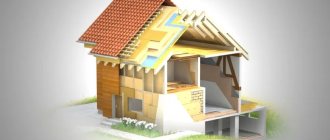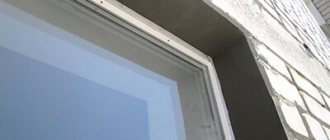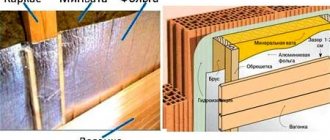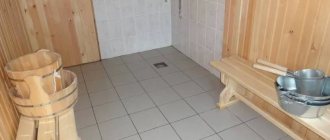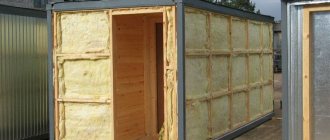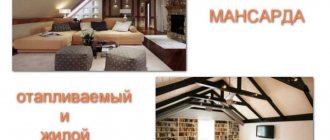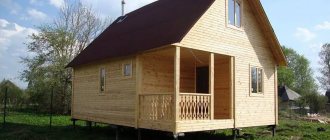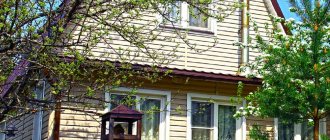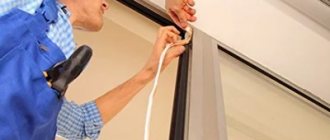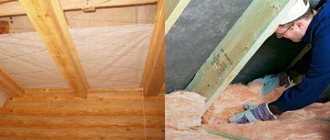It is believed that if the temperature inside the garage does not drop below +3C, then the car engine can be started, as they say, “half a turn”. Therefore, owners today pay special attention to the insulation of metal garages. Moreover, there are thermal insulation materials on the market today, with the help of which the insulation process is carried out simply and quickly, plus the costs for this event are not very large. Therefore, in the article we will consider all the methods of insulating garages built from a metal profile sheathed with sheet iron or corrugated board.
How to properly insulate a metal garage Source gallery.ykt.ru
Why insulate walls
The enclosing structures of buildings for cars are made of large-block materials, for example, cinder block or gas block, less often of brick.
Depending on the method of laying the products, the thickness of such walls will range from 12 to 30 centimeters. This width is not enough to protect the room from the penetration of cold air. Even when installing a heating system, the difference between the air temperature outside and inside the building will lead to condensation. There is no need to artificially increase the temperature in the garage to high levels. After a car enters a warm room from a cold street, condensation will certainly appear on its surface, which will lead to corrosion of the metal. Thermal insulation of the garage should be selected and installed in such a way that the difference in temperature in the room and outside the window is minimal. The optimal performance for a car is considered to be +5 degrees.
Note! When insulating building envelopes, motorists seal all cracks, including ventilation holes. It is prohibited to clog exhaust pipes; they are used to remove accumulated moisture and help remove carbon monoxide from the room.
Paneling
A popular method of interior finishing is paneling; it makes the room attractive, gives it a lived-in look and is ideal when thermal insulation is needed. When you know how you will use the garage space, choosing a material becomes much easier. If your garage will combine the functions of a service station and a workshop, you will need corrugated sheeting with its strength and non-flammability. If you plan to carry out only simple maintenance yourself, you can opt for PVC. If the garage is a place for restoring mental strength while simultaneously polishing an iron friend, there are no restrictions on the choice of material. The garage is finished using the following types of panel materials:
Cladding with PVC panels
Interior decoration of walls and ceilings with PVC panels is widespread and suitable for many owners of permanent garages; its advantages include the following qualities:
Availability
. Nice price/quality ratio.
Physical properties
. The material is moisture resistant and does not require additional processing (painting).
Panels for every taste
Easy installation
and unpretentious care.
Light weight
. Covering the gate with plastic does not increase the weight of the gates and does not load the hinges or frame structure.
Using the Frame
for fastening panels. It can be used to insulate a building, for example, with slab mineral wool.
Cheap repairs
in case of damage. It is easy to replace one part without disassembling the entire structure.
The disadvantages of using vinyl siding as garage trim include:
Low mechanical strength
. When hit, the panel is easily deformed.
Sensitivity to temperature changes
. You can purchase more reliable (and expensive) panels for facade work or special ones for the garage. This material is designed for the fact that the garage is most often not heated, and therefore has improved characteristics.
Wooden lining
The main raw material for the production of natural lining is coniferous wood, usually pine. This material is cheap, easy to process, and safe for health. Covering a garage space with clapboard will pay off if the wood has undergone preliminary protective treatment with an antiseptic and fire retardant. The positive qualities of wooden lining include the following properties:
Ecological cleanliness
and durability.
Availability
for a wide range of consumers.
Simple and reliable installation
. The lining is laid on a wooden sheathing or on a plastered wall. The parts have a notch-ridge connection system, due to which they fit tightly to each other.
Strength
and frost resistance
.
Resistance to mechanical stress
.
Natural texture
and a large selection of natural shades.
The disadvantages of wooden lining include the following features:
Biothreat Exposure
. In a room with high humidity, there is a high likelihood of mold and pests.
Flammability
. It decreases somewhat after using a fire retardant.
Difficult care
. It can be difficult to clean the wall from oil stains, so it is recommended to cover the wooden paneling with a layer of varnish that protects the wood from absorption.
This might be interesting!
In the article at the following link, read about decorating walls with clapboard in a wooden house.
Sheathing with plasterboard
When thinking about how to cover the inside of a garage, many people pay attention to drywall (dry plaster). To decorate a garage space, it is recommended to use a material with improved moisture and fire resistance properties. Such sheets have the designation GKLVO, a characteristic gray-green color and red markings. Using drywall has obvious advantages:
Light weight
material. The sheets are attached to a special adhesive solution or a metal frame. The second method is convenient when the walls are uneven or insulation is necessary.
Easy installation
with a minimum of construction waste (compared to classic plaster).
Use as a base
. Ceramic tiles can be fixed to the material (if it was used to level the walls) or relief plaster can be applied.
Use as a partition
. Drywall attached to a frame is suitable if you want to allocate space in the garage for a mini-warehouse or locker room.
Changing shape
. Drywall is suitable for forming not only flat, but also arched structures (after preliminary preparation).
Cladding garage walls and ceilings with plasterboard installed on a frame has its disadvantages:
Unprofitable for a small room. The frame reduces the already small free space.
Low impact resistance of walls. If it is planned to cover the plasterboard with a durable material (for example, ceramic tiles), the disadvantage disappears.
Sheathing with moisture-resistant plasterboard This may be interesting!
The construction of a permanent garage requires high-quality insulation. In the article at the following link, read about how to choose a material for internal insulation.
Sheathing with OSB sheets
As an option for finishing garage walls, you can find plywood and other wood-based materials. OSB (oriented strand board) sheets, which are made from a mixture of crushed wood and various binding additives, are well suited for constructing insulated walls. For covering garage walls (and ceilings), the best option is sheets marked OSB-3 or OSB-4. OSB-3 material is the most common choice for finishing a garage. It is characterized by good strength and average moisture resistance, therefore it requires additional moisture-proof treatment. OSB-4 is a more durable option with the following advantages:
Long service life
.
Durability and resistance to temperature changes
.
Good moisture protection
. The material does not deform in conditions of high humidity.
Mold resistance
(the composition contains antiseptic additives).
Interior decoration of a garage with OSB panels also has disadvantages:
The material belongs to the highest category of flammability
(G4).
Evaporation of harmful substances
. The sheets contain formaldehyde resins, the evaporation of which is harmful to health, but, with ventilation, can have an acceptable level.
Corrugated sheet
One of the options for practical and cheap cladding is corrugated sheeting - a profiled steel sheet protected by a polymer or paint coating. Like the lining, it is convenient to attach it to a wooden sheathing. The corrugated sheet has the following features:
Durability
and non-flammability.
Resistance to temperature changes
and to aggressive environments.
Quick installation
, provided by large sizes of material.
Main disadvantage
corrugated sheeting –
susceptibility to corrosion
.
Replacement
A bent corrugated sheet
will cost more
than repairing vinyl siding (PVC panels).
Sheathing with corrugated sheets This may be interesting!
In the article at the following link, read about corrugated roofing: sheet sizes and price.
What material to use for this?
In fact, the question here will be solely in the budget allocated for the event. If savings are needed, then there is only one option - polystyrene foam. If you have a little more money, then mineral wool is the optimal solution. Exotic sprayed polyurethane foam will surpass the main types of thermal insulators in properties and efficiency, but it will be the most expensive option and, besides, you won’t be able to create such thermal protection with your own hands; you need to have certain knowledge of the technology, as well as special equipment. Therefore, there are few options:
The last option, as already mentioned, is too expensive and it is not easy to implement such insulation, even with the necessary knowledge and tools. Therefore, we will consider the most affordable and simple types of thermal insulation.
Floor and ceiling finishing
The roof for garages is usually made flat. This saves money and effort, but at the same time increases the likelihood of leakage when water after rain lingers on a horizontal surface. Therefore, the decorative covering of the ceiling in the garage begins after waterproofing it. One of the most common methods is plastering the ceiling and then painting it. Since the ceiling is not damaged, the choice is often made in favor of MDF or PVC panels. This is a popular and practical option that allows (when using a frame) insulation and hiding communication systems.
The flooring in the garage has special requirements; it must withstand significant and regular weight loads from the car. The preferred flooring options are:
Painted concrete floor
. A popular option that can easily withstand the weight of a car. A concrete floor coated with a primer weakly absorbs spilled auto chemicals, does not collect dust and is resistant to abrasion. Although the process of installing a concrete floor cannot be called quick, many car enthusiasts opt for it due to the low costs and simplicity of the technology.
Tile
. A garage floor made of ceramic tiles (or ceramic tiles) looks neat and often original. The coating is advantageous due to its durability, easy maintenance and resistance to fuels and lubricants. The limiter to the use of tiles is their high cost and the rather labor-intensive process of creating a tile covering (including mandatory waterproofing).
Ceramic tile flooring
Self-leveling concrete
. Impact-resistant coating with a perfectly flat surface, not inferior in strength to a classic concrete floor. One of the most successful coatings for a garage, as it is frost-resistant and has increased resistance to chemical environments. The disadvantage of this method is the high price of the composition, which is why self-leveling flooring cannot be called an economical option. Another subtlety is that the base for pouring must be perfectly flat, which is not always achievable.
Wooden floor
. The choice in favor of a wooden floor covering (from floorboards) is not often made, although the base for such a floor does not need to be leveled. Many believe that this type of floor has more disadvantages than advantages - flammability, high degree of absorption and low strength. Proponents claim that wood flooring is much more pleasant and healthier to work on; In addition, wood (unlike concrete) does not generate dust.
Self-leveling polymer floor This might be interesting!
In the article at the following link, read about projects of houses with a garage.
What materials are suitable for insulating a garage?
Mineral wool
An important advantage of using mineral wool to insulate a garage with your own hands is the ability to create a “breathable” insulation layer. The fibrous structure of the cotton wool does not interfere with the natural circulation of air inside the garage; exhaust gases, evaporation of fuel and other technical liquids, which are always stored in abundance on the shelves, will quickly erode outside without stagnating or poisoning the air. An additional argument in favor of cotton wool can be its non-flammability. In a garage where there is a lot of flammable stuff, this can be a deciding factor.
Among all the variety, it is recommended to choose basalt or stone wool. It has the best thermal conductivity of 0.03-0.1 W/m °C and at the same time serves as excellent sound insulation.
The easiest way to lay mineral wool is in the form of semi-rigid mats. The mats fit tightly into the spacer of the frame mounted from timber or galvanized profile on the internal surfaces of the garage: walls, ceiling, gates
And don’t forget that in order for mineral wool to preserve its thermal insulation properties, it is important to use a vapor barrier membrane that will remove excess condensation and prevent moisture from accumulating inside the insulation
Styrofoam
Polystyrene foam is perhaps the most popular material for do-it-yourself garage insulation. It can be cut and processed without problems using simple tools, such as a knife. It has extremely low thermal conductivity - only 0.03-0.04 W/m °C. And it's cheap.
Although there were some downsides. Polystyrene foam noticeably “eats” the internal space and is also flammable; it is better to keep a fire extinguisher in a visible place.
You can mount foam sheets on internal surfaces using polystyrene glue, polyurethane foam or plastic dowels (they will require sheathing). The optimal thickness of the insulating layer is 50-100 mm. The joints must be sealed with polyurethane foam.
Thermal insulation plaster
In addition to the binder element, gypsum or cement, such plaster contains porous materials - quartz sand, vermiculite or expanded polystyrene, which provide heat-insulating properties. Thermal conductivity coefficient of “warm” plaster: 0.065 to 0.13 W/m °C.
Heat-insulating plaster is applied to the walls and ceiling using standard technology: installing beacons, preparing the mixture, applying the mixture to the surface, leveling. It is recommended to apply one or two layers up to 50 mm thick on the walls, and one layer of 5-30 mm on the ceiling.
It is best to use insulating plaster for garages made of brick or cinder blocks. It will insulate the room and allow you to level the walls and ceiling.
Thermal insulation paint
Thermal insulation paint is a new word in room insulation. It is a polymer composite filled with hollow ceramic microspheres.
Read more about the structure and features of thermal insulation paint in the article All about ultra-thin ceramic thermal insulation
The thermal conductivity of the paint is about 0.065 W/m °C, which is approximately comparable to “warm” plaster. Only the insulation layer will be only 2-4 mm. What a saving of internal space.
In its finished form, the insulation is a liquid consistency, which is applied like regular paint, using a brush, roller or spray gun. This method of application will be especially appreciated by owners of metal garages. After all, the internal surfaces of such garages have a complex profile due to various corners, beams and protruding fasteners, and it is quite difficult to attach a tight-fitting layer of insulation to them. But painting the surface of any profile, no matter how complex, is not difficult.
However, it would be a mistake to assume that a thin layer of heat-insulating paint will create the desired microclimate in the garage. Yes, it can replace a fairly thick layer of traditional insulation. But for the desired result - +5°C inside the garage - you will still need to supplement it with a layer of another insulation, mineral wool or polystyrene foam.
Video description
We invite you to watch a video that shows the technology of thermal insulation of a metal garage with polystyrene foam boards:
See also: Catalog of companies that specialize in insulating country houses.
Additional wooden frame
This option for insulation and finishing is used if the frame of a garage building is assembled from a steel corner. To do this, wooden blocks with a cross-section equal to the side of the corner profile are installed on both sides of the corner elements. Usually this is 40 mm, which means you will need 40x40 mm bars.
They are attached to the frame structure in different ways, for example:
- tie two bars of wire to the corner on both sides at once;
- attach each block to the garage wall , that is, to a metal sheet, making holes in it and securing it with self-tapping screws, which are screwed in from the outside.
That is, another frame should appear on the inner wall, only wooden. It is the dimensions of the newly formed rectangles that are used as the basis for trimming the polystyrene foam boards. After which they are also inserted into the spaces between the frame elements and secured with adhesive. Sometimes glue is not used if the trimmed pieces of insulation fit tightly into the wooden structure of the sheathing. They won't fall out, especially since they will be covered with casing.
Now any finishing lath, slab, or sheet material can be installed on a wooden sheathing using standard technology.
Thermal insulation with polystyrene foam with installation of a wooden frame Source 2gis.ru
Why do you need to insulate your garage?
The temperature regime that has a positive effect on the condition of the car differs significantly from the one in which a person is comfortable. If in residential premises the standard is to maintain the air temperature at +20-22 degrees Celsius, then for storing a car +5 degrees is considered the most optimal. At this temperature, almost no condensation forms on metal parts, causing destructive corrosion.
Therefore, to create a microclimate suitable for technology in the garage, other approaches to insulation are used. After all, the desire to recreate room conditions in the garage using insulation and heating devices will harm the vehicle. For example, in winter, when entering a heated room from the cold, the car will instantly fog up, the air humidity will increase, and the car will sit in such a warm-humid fog all night.
How to properly insulate a garage? Let's figure it out.
Preparatory stage
When lining metal structures, it is paramount to take care of anti-corrosion treatment. To do this, you need to clean off any rust that is present on the surfaces with a metal brush, carry out patch repairs (of a specific small area) if necessary, and then paint the surface with a special anti-corrosion solution.
Sometimes the right question arises - how to insulate a metal garage for a long time if the surface is treated? The second important factor in ensuring comfortable conditions inside the garage is the creation of ventilation. It should remove air from the garage, replacing it with fresh air. Otherwise, the accumulation of gases will cause condensation, which will negatively affect the supporting structure of the garage, car or stored food.
After waiting for 1-2 days for the applied anti-corrosion solution to completely dry, the insulation of the metal box from the inside begins. It is advisable to carry out the work in the following sequence - insulate the walls, then the ceiling, the gate with a wicket, and, if necessary, the floor.
Types of thermal insulation materials for garage walls
In the modern construction market there is a huge selection of insulation materials. Let's consider the characteristics of the most popular thermal insulation materials:
- Mineral wool is supplied to stores in the form of rigid mats with a density of up to 240 kg/m3. Such products are characterized by high resistance to fire and allow water vapor to pass through their structure (breathe). The only disadvantage of using basalt wool is the need to install a vapor barrier film, which will protect the product from getting wet. When exposed to moisture, the insulation loses its properties.
- Glass wool is considered a cheaper analogue of mineral wool. Such products consist of hard and prickly fibers, so you need to wear glasses and gloves when working with insulation. After getting wet, the mats clump and become heavy, so glass wool needs to be protected from moisture penetration by laying special films or foil.
- Polystyrene foam is considered the most convenient thermal insulation material to use. The products are not afraid of dampness, can be easily cut into pieces with a regular hacksaw, and are affordable. Insulation of a garage can be done using an analogue of polystyrene foam, polystyrene foam, which will last up to 40 years. The main disadvantages of the products in question are considered to be flammability and low resistance to sunlight. Foam plastic unprotected by plaster turns yellow and crumbles.
- Another insulation for the garage, warm plaster consists of vermiculite or foam balls. Such materials have good heat-insulating qualities, but to obtain maximum effect, a thick layer of mortar must be applied to the walls.
How to line a garage from the inside inexpensively: special requirements
In addition to the main purpose of construction - comfortable and safe storage of the car - the garage also performs other functions.
When troubleshooting machine malfunctions and breakdowns, the room turns into a workshop with all its attributes: heavy tools, bulky mechanisms, dismantled and spare units, stained with engine oil.
The constant presence of flammable fuel in the car tank and in spare cans places increased fire safety requirements on interior wall finishing and their resistance to toxic chemicals.
How to decorate the walls in the garage inexpensively? Nowadays, the choice of finishing materials is so great that we will focus only on some of the most budget-friendly materials for covering interior walls.
At the same time, we remember the key requirements for garage finishing: durable , inexpensive , beautiful .
Wooden lining
Wooden lining , the ultimate dream of a garage owner just 15-20 years ago, has long been lost among modern plastic descendants.
How to decorate garage walls cheaply? Maybe a tree . After all, this material is high-quality, durable and aesthetic. Polished panels made of precious wood decorate the interiors of palaces and the interiors of expensive limousines. Traditionally, saunas and bathhouses are lined with wood with low thermal conductivity to avoid getting burned on the walls.
But in a garage, where there is already an abundance of flammable substances, it is extremely unwise . In such a room it will be dangerous not only to carry out any welding work if necessary, to install a heating stove, but even to simply smoke.
Timeless technology
However, modern types of lining made of plastic , composite polymers and metal traditionally continue to copy wooden boards and panels, although the design imitates both brick and stone.
After all, such a universal, time-tested form allows you to use the best quality inherent in the lining - it can be easily mounted on a lathing made of wooden beams.
Another advantage of timeless technology is that the lathing allows you conveniently install any insulation under the lining, hide cables, utility pipes, and ventilation ducts.
All types of lining, despite the differences in materials and profiles, are similar in the installation principle: ridges and grooves at the ends of the panels allow them to cover walls without gaps . Each subsequent panel also hides the fastening elements of the previous one.
Metal lining
This siding has all the advantages of metal products - increased strength, durability, resistance to aggressive environments and temperature influences, and non-flammability.
The disadvantages of metal are also presented here, the main one being susceptibility to corrosion . Metal lining is made of aluminum and steel.
Corrugated sheet
How to line the inside of a garage cheaply? One option is durable corrugated sheeting . These are profiled steel sheets with a protective polymer coating. Like lining, corrugated sheeting can be fixed to a wooden sheathing. And the speed of installation will be ensured by large sheet sizes.
Vinyl siding
The composition of the filling of PVC panels (short for the term PolyVinyl Chloride) is non-flammable materials. The panel melts, but only smokes without forming an open flame. In the event of a fire, such smoke can extinguish the fire that caused it, displacing oxygen from the air in the room. But this toxic smoke is also dangerous .
However, garage owners willingly buy PVC panels for finishing walls, both internal and external, not for experiments with fire.
Wonderful vinyl siding meets our requirements. Durable, inexpensive, beautiful.
Moreover, it is waterproof, does not rot, does not warp due to temperature changes, is resistant to contact with garage chemicals, does not require painting or maintenance, and can be washed from almost any contaminant.
This siding will last for decades.
PVC panels also eliminate nostalgia for the good old lining. The volumetric imitation of the texture and shades of wood on the surface of the panels is indistinguishably realistic. Except they don’t smell like pine...
Polyurethane foam for garage insulation
And a few words about polyurethane foam, the thermal conductivity of which is 0.019 W/m K. That is, it is better than polystyrene foam. But it is more expensive and requires special equipment to apply it. Until recently, such equipment consisted of huge containers and a compressor. Today, manufacturers offer compact devices whose weight does not exceed 30 kg.
These are two cylinders and a mini-compressor with hoses and nozzles. The cylinders contain two components that are connected and supplied through hoses under pressure
The applied layer is thin (15-20 mm), please note - it is continuous, without seams or joints, and is more effective than many modern thermal insulation materials used for insulating garages. But if we compare the cost, then it is inferior to the same polystyrene foam
Although good insulation cannot be cheap.
Insulation of a metal garage with polyurethane foam
There are several effective and inexpensive technologies for insulating iron garages. But, as practice shows, polystyrene foam is most often used if the conversation turns to DIY processes. There are no restrictions or contraindications in the use of this material. At the same time, the insulation has a number of good technical characteristics, plus the low price of the product itself.
External or internal insulation
The best option is external insulation. In this way, a shift in the dew point (formation of condensation at the border of contact between cold and warm air) is achieved closer to the outer surfaces of the insulating layer. And if you choose the right thermal insulation material with the lowest possible thermal conductivity, you can achieve a shift in the dew point to the finishing surface. The second positive factor is the low internal volume of the garage space in terms of overall dimensions.
*
As practice shows, this method is applicable if the garage is a separate building. If the task is to insulate a structure located in a row of several garages, then thermal insulation processes will have to be carried out from inside the building.
External insulation with polyurethane foam
*
How to insulate garage doors
Not everyone knows how to properly insulate a garage from the inside. Effective and reliable thermal insulation of walls will not be enough, because a significant amount of heat escapes through the gate. The lack of insulation in this design will not allow the garage to warm up to the required temperature levels. At the initial stage of work, a hole is made in one of the doors and the doors are inserted. To reduce heat loss, a curtain made of thick fabric is fixed in this place.
A transparent polyethylene film with a minimum thickness of 0.8 millimeters will help to insulate the entire plane of the gate. This material is cut into strips 20-30 centimeters wide and fixed above the opening, so that the lower edge does not reach the floor surface by 1-2 centimeters. The strips are secured to a wooden beam using staplers. This insulation is very effective - when entering the garage, the driver will see the surrounding space. In addition, narrow strips of polyethylene will smoothly flow around the car and return to their original position.
Some car enthusiasts insulate the inside of their garage doors with polystyrene foam. To do this, a sheathing of wooden blocks is installed on the inside of the structure and the voids are filled with polystyrene foam slabs. To prevent cold air from penetrating through the gaps, the joints of the thermal insulation are taped with tape.
To eliminate drafts entering through the gates, it is necessary to replace the rubber seals. Condensation forms where the thermal insulation comes into contact with the metal surface. To prevent destruction, the steel is treated with paint or other anti-corrosion compound. Waterproofing substances are also applied to other surfaces.
The wooden guide elements of the frame are coated with a primer or heated drying oil, which will protect the material from rotting and exposure to fungus. After laying the foam, the surface is cleaned. Garage doors are finished with OSB boards or thin boards. It is not advisable to use moisture-resistant products for this, for example, gypsum board.
Required Tools
It is advisable to insulate the garage in the warm season, but sometimes the situation forces you to carry out work at sub-zero temperatures. Here there is a need to insulate the box quickly and reliably. To use time efficiently, the following equipment is prepared in advance:
- electric drill;
- mask and gloves (protective);
- welding machine;
- building level;
- screwdriver;
- self-tapping screws;
- metal scissors;
- tape measure from 5 m;
- staples and furniture stapler;
- wooden blocks for the horizontal crossbars of the sheathing;
- steel profile.
If all of the above is present, it’s time to start insulating the garage from the inside.
Insulation of walls from the inside
The choice of insulation, as well as the technology for insulating enclosing structures, will depend on the material from which the enclosing structures are made. Many car enthusiasts are interested in the question of how to insulate a brick garage. First you need to clean the surface from dust and dirt, mount a frame into which the thermal insulation will be installed.
The sheathing is made from a plasterboard profile. The guides are fixed to the wall with dowels, which are driven in every 30 centimeters. The distance between the guides must correspond to the width of the insulation boards. To finish the walls, you can use sheets of plasterboard or asbestos fiber. It is better to use the latest products, because they have a high degree of fire resistance compared to similar materials.
Advice! Asbestos fiber is quite fragile; to prevent its destruction as a result of various mechanical influences, reduce the pitch between the frame guides.
Insulation of garage walls from the inside is carried out using mineral wool or other products made in the form of slabs. In this case, the mats are inserted between the guides, their position is fixed using special hooks. After this, they begin to install the vapor barrier membrane, which should be connected to the cotton wool insulation.
We also insulate the garage from the outside, using warm plaster or special paint. Carrying out such work shifts the dew point, which will protect the walls from moisture penetration and further freezing. The owner of the building must install forced ventilation. This system is designed for intensive air exchange.
Insulating a garage with foam plastic is suitable for insulating metal walls. Expanded polystyrene boards are fixed to the base surface using an adhesive mixture. To securely fix the thermal insulation, it is necessary to first clean and degrease the metal. The sheets are fixed to the walls with the seams aligned, and polyurethane foam is poured into the gaps. Polystyrene foam is subject to combustion, so a thin layer of plaster must be applied to its surface.
Metal garage walls are often insulated with polyurethane foam or special paint. If there are voids between the frame, insulation is carried out using penoizol. The liquid mass penetrates into the wall through special holes. The foam clings well to surrounding surfaces, hardens, turning into high-quality and reliable thermal insulation.
How to insulate with foam plastic
The process of insulating a metal garage with polystyrene foam consists of two stages: preparation and installation of the insulation. The preparatory process includes cleaning the surfaces of the metal sheets that form the roof and walls from dirt, rust and peeling paint. Any method that guarantees the quality of the final result will do. Most often, ordinary sandpaper is used for this. To increase the speed of the procedure, use a grinder with an attachment in the form of a metal brush.
Now about the adhesive composition. Since a metal structure is subject to insulation, it is better to use special glue in a can for polystyrene foam boards. This is a universal adhesive material in the form of foam, which guarantees the strength of the insulation to the metal. It is resistant to moisture and temperature changes. One can is enough to fasten 10 m² of slabs; it takes 30 minutes to harden.
Attention! Polystyrene foam does not expand in volume after its application, like mounting foam.
Foam for expanded polystyrene
Please note that the walls and roof of the garage are steel sheets welded to the frame of the building. The latter is made from a metal profile, usually from a 50x50 mm corner. The frame is covered with sheets of iron from the outside, that is, it remains inside. Therefore, it is important to precisely cut the sheets of polystyrene foam to the dimensions of the frame structure so that the insulation lies between the frame elements, pressing tightly against them. Trimming is done with a sharp knife.
Now you need to apply glue to the slabs: along the perimeter and diagonally. Expanded polystyrene sheets are placed at the installation site and pressed with your hands, but not too much. Installation is best done from bottom to top. There are several points to pay attention to:
- Insulation boards have a low specific gravity, which makes it possible not to install supporting elements on the vertical planes of the walls. The foam itself is enough. But you will have to think about supports on the roof slopes. One option is regular tape, one end of which is glued to the insulation, the other to the steel frame element.
- If there is a small gap between the slabs of heat-insulating material and the garage frame, you just need to foam it with glue.
Gates and doors are insulated in the same way as garage walls.
Installing polystyrene foam boards with glue
Design features of the garage that affect the insulation process
The main feature of the garage, which directly affects the insulation technology, is the thin walls and roof. Even garages built from brick or cinder blocks rarely have a wall thickness of more than 25 cm. And the thickness of metal garages is measured in millimeters. Such walls are not able to provide the necessary thermal insulation and require proper insulation.
For comparison, in residential premises the thickness of external brick walls ranges from 51 cm (two-brick masonry) to 64 cm (two-and-a-half brick masonry).
When choosing future insulation and calculating the thickness of its layer, you need to strive to ensure that the temperature inside the garage is maintained just above zero.
Moreover, if installed correctly, the insulating layer will work for the desired result at any time of the year: in winter it will retain heat inside the garage, and in summer it will prevent heating outside. This is achieved due to the so-called thermal inertia, which occurs due to a decrease in the thermal conductivity of surfaces in the direction from outside to inside.
You can create the desired direction of thermal inertia by insulating the garage from the inside. Then, outside in relation to the external atmosphere, there will be a material with higher thermal conductivity - cinder blocks, brickwork or metal, and inside - thermal insulation with low thermal conductivity.
Garage interior decoration
*
The difficulty of finishing the interior of a metal garage after thermal insulation work is that there is nothing to attach the finishing material to. If a frame method of insulation were used, that is, with the installation of a frame made of wooden slats, then the finishing would be attached to it. But since the simplest option was considered - frameless, it is necessary to tell how you can attach, for example, a plywood sheet to the garage wall.
To do this, you will have to carry out additional preparation, which consists of welding a certain number of M6 or M8 bolts from the inside to the steel sheets that form the surfaces of the garage structure. The caps must be welded to sheets of iron.
The length of the fastener is selected based on the thickness of the insulation and the thickness of the finish. For example, the thickness of the foam is 50 mm, the thickness of the plywood is 8 mm, which means that you will need bolts 70 mm long, where 12 mm will be spent on fastening with a nut and washer. The number of fasteners is determined by the distance between them. There is no exact data here, so approximately 40-50 cm.
The process of insulation on fasteners is carried out in the following sequence:
- An adhesive composition is applied to the foam sheet;
- it is placed in the required place and pressed tightly with your hands;
- insulation – the material is loose, so the bolts will pass through it easily;
- The finishing material is cut to the required size;
- the ends of the bolts are treated with chalk or paint;
- apply the finishing panel to the required place; traces of chalk or paint will remain on its surface;
- holes are made according to the marks using a drill and a drill bit, the diameter of which should be slightly larger than the diameter of the bolts;
- the finishing panel is put on fasteners and clamped with nuts, under which wide washers must be placed.
Attaching foam and fiberboard sheets to garage doors
Insulating a garage from the inside with bricks
There are no contraindications to using brick to insulate a garage from the inside. Just brick cladding will reduce the volume of the building. This is a more complex process in terms of work, and it is more expensive than using foam plastic. In addition, in terms of thermal conductivity, brick is much inferior to polystyrene foam boards:
- 0.81 W/m K – thermal conductivity of solid brick;
- 0.032 – 0.044 W/m K – range of thermal conductivity of foam depending on its density.
It turns out that polystyrene foam laid 30 mm thick replaces a masonry of three bricks laid lengthwise.
How to insulate a cellar in a garage
Insulating a cellar in a garage is technologically not much different from insulating premises for other purposes, but has several important nuances. The main one is increased humidity due to direct contact of the walls and floor of the cellar with the soil. Therefore, waterproofing becomes a key step.
Ideally, it is better to apply a layer of waterproofing to the outer surfaces of the walls, creating an airtight capsule around the cellar. However, in an already built garage or a garage located in a cooperative, it is sometimes impossible to reach the outer surface. In this case, waterproofing is done from the inside.
Polymer films, roll insulation or bitumen mastics can be used as a waterproofing material. The result should be a complete layer of waterproofing. A special vapor-waterproofing membrane is suitable for insulating the ceiling.
Then, insulation is laid on the walls, floor and ceiling: mineral wool, polystyrene foam or extruded polystyrene foam. For mineral wool, you will need to build a frame, and sheets of polystyrene foam are glued to surfaces or secured with plastic dowels with a mushroom cap.
A wooden frame for installing mineral wool must be treated with protective compounds.
The top layer of insulation is covered with a vapor barrier. After which you can begin covering it with decorative materials, for example, plastic panels.
How and with what to cover the inside of a garage inexpensively? Selection of materials
Even at the project stage, the owners think through the aesthetic and functional decoration of the garage walls.
There are construction options in which interior decoration is not required at all (for example, neat brickwork of walls).
But such common wall materials as cinder blocks, foam blocks, sawn limestone or shell rock are initially intended for subsequent finishing .
Built into a basement made of large foundation blocks, the garage resembles a concrete cave; you just want to hide the walls behind the cladding .
The problem of finishing interior walls also arises when purchasing an old garage on the secondary real estate market. Therefore, the question arises : How to decorate the inside of a garage cheaply?
Do I need to insulate the floor in the garage?
Whether to insulate the garage floor or not is up to everyone to decide for themselves. From the point of view of complete thermal insulation of the internal space, it is of course better to insulate. After all, through a floor laid directly on the ground, cold will always enter in late autumn and winter, disturbing the balance of the microclimate.
On the other hand, insulating the floor of an already built garage can be quite a difficult task. After all, after installing the insulation, the floor level will rise to a height of 10 to 20 cm. At a minimum, this will create problems when driving the car. And at the very least, it will make it impossible to park your car in the garage due to the fact that it will no longer fit through the gate.
Therefore, before you start insulating the floor, you need to carefully measure everything and find out whether there is enough headroom.
Among the options for do-it-yourself garage floor insulation, two main approaches can be distinguished:
- Quick modification of the floor to reduce heat loss.
- Installation of a full layer of insulation.
For the first option, when time, and most importantly finances, are limited, you can cover the garage floor with boards or OSB boards. Of course, this cannot be called serious insulation, but a noticeable effect will still appear. The floor will no longer be cold, and an additional air layer will appear under the flooring, holding back the cold from the base of the floor.
The second option is to fully insulate the floor by creating a multi-layer thermal insulation cake.
Taking into account the fact that the car puts a significant load on the garage floor, extruded polystyrene foam would be the best insulation option.
Where is it better to insulate - inside or outside?
Some garage owners argue that it is better to insulate the room from the outside, as this will significantly save interior space. We really have to agree with this. Some thermal insulation materials begin to release substances harmful to humans into the air when interacting with the environment. They are dangerous to install indoors, but they are perfect for external thermal insulation.
But there is also the other side of the coin - the insulation materials used will be constantly affected by precipitation: snow, rain, hail, strong gusts of wind, etc. Therefore, the service life of materials is reduced to 2-3 years, while indoors they can last 10 years, or even more.
You can insulate the garage both outside and inside at the same time. At least the roof. This will help get rid of condensation that may collect on the roof and drip through cracks.
Floor insulation
If the garage has a cellar for storing canned goods, vegetables and fruits, there is no need for floor insulation. In the absence of such an underground room, insulation is mandatory. The easiest way to insulate the floor is with foam boards. The whole workflow boils down to the following:
- vacuum the base and remove dirt;
- lay roofing material or plastic film on the base;
- we fix sheets of polystyrene foam of maximum density (the thickness of the cake is at least 10 centimeters);
- we lay waterproofing material and reinforcing mesh;
- We install the beacons and fill in the leveling screed.
By following the recommendations given, you can quickly insulate all structural elements of the garage. At the final stage of work, surfaces are painted or finished with the selected material.
Arrangement of gate lathing
- After fixing the sheathing, the slab material is cut to the required size (as accurately as possible to avoid large gaps).
- It is glued to the base and the seams are sealed with polyurethane foam.
- Next, finishing is carried out using forcing or other material. OSB panels and plywood are also used for sheathing.
Izolon or a regular layer of foil glued on top of a sheet of foam multiplies the heat-reflecting effect several times. Many people heat the UFO garage with a radiator. The rays from the foil base are well reflected, even under the skin.
Foam plastic and all its analogues
The insulation technology in this case is incredibly simple. It is first necessary to carry out several measures to prepare the work front - treat the walls with antiseptics and prime them. If necessary, degreasing is carried out - for metal surfaces. Next, the foam boards are simply glued to the plane without gaps or cracks. If they do form, then after finishing the work, all existing flaws are filled with polyurethane foam. There is a more complex method for assembling wood sheathing, the same as for mineral wool. The principle of its assembly will be the same in both cases, so you can simply consider it further.
Foam insulation
Foam insulation has the structure of polyurethane foam:
- Manufacturers of the material assure that the service life of the insulation is up to 50 years or longer. Very durable insulating material. The foam is durable and slightly inferior in thermal insulation properties to penoplex;
- This method has its disadvantages - the high cost of the material. To install thermal insulation, you need a specialist with expensive equipment for distributing foam;
- In principle, it is the same polystyrene foam, only in a cylinder. It has the advantage of seamless installation.
Polyurethane foam is not used as the main insulation due to its high cost; it is used to treat joints of tile insulation (foam plastic, polystyrene foam)
Mineral wool
Preparation of the base for insulation is carried out similarly to the previous option, but insulation of the garage walls from the inside in this case will differ in technology. First, you should assemble the sheathing from wood or metal parts. Usually, these are familiar profiles intended for installation of gypsum plasterboard structures. The installation step of the elements almost corresponds to the width of a roll of mineral wool or a hard mat made of the same material, but slightly smaller. This way the insulation will be securely fixed in the cells of the frame.
Next, you should take care to protect the insulator from moisture and lay a layer of waterproofing. Rigid mats of cotton wool insulation are placed inside the cells or pieces of rolled wool cut to size are inserted. The resulting structure is covered with a layer of vapor barrier and decorated to your liking. It should be taken into account that mineral wool will completely lose its properties when it gets wet and protect it as best as possible from water.
Entrance trim
Insulating walls will not be beneficial if cold air enters through the cracks of the entrance gate or wicket. The situation is easily solved by using rigid insulation such as polystyrene foam. First, the gates are insulated, then the small entrance door to them is insulated. The sequence is:
- The metal surface is treated with protective mastic. Expanded polystyrene is not afraid of moisture, however, when opening the gate, raindrops or snow can get into the cracks between the material and the iron sheet. This should not be allowed.
- Attach lathing profiles along the perimeter of the gate.
- Fix the polystyrene plates to the mounting adhesive; it is advisable to apply penofol (a foil-based material) on top of them.
- Make a wooden sheathing for installation of the cladding. Provide a distance of about 30 mm between the future lining/plasterboard/other cladding material and polystyrene foam, so that there is an air gap.
- Fix the cladding to the sheathing.
- Perform similar actions with the gate.
What features should insulation have and why?
All materials that can be used for thermal protection must meet the following requirements:
Thermal conductivity
This indicator is responsible for the ability of insulation to transfer heat. The lower this coefficient, the less heat the material transmits. This means that in winter the insulation prevents the building from quickly cooling down and, accordingly, from warming up in summer.
Advice! Based on this indicator when choosing, the user must take into account the thermal conductivity coefficient when used in specific climatic conditions.
Fire safety
This indicator is responsible for the ability of insulation to withstand high temperatures without losing its functions, without deforming, without changing its structure. Insulation of frame houses with mineral wool is considered reasonable and correct because this indicator is regulated by GOST standards. Mineral wool has them and fully meets them.
Water absorption
The next important parameter after the previous one is responsible for the ability of the material to absorb moisture and retain it. If the material absorbs water strongly, it releases heat faster and stronger. This happens because the pores in the insulation are clogged with water, and, according to the laws of physics, it has greater thermal conductivity than air.
And then, if the moisture absorption is too high, the material, at too low a temperature, can simply freeze, and when it turns into ice, it can completely lose its properties.
Therefore, the smaller its parameters, the better the material.
Shrinkage
When choosing to insulate a frame house with high-quality mineral wool, you should also pay attention to this parameter. This coefficient should be as small as possible. Otherwise, over time, after shrinkage, subsidence will begin to appear in the places where the heat insulation is laid. This means that cold bridges will definitely appear there, and this is very bad. A cold bridge is an ideal area for removing heat from inside a room.
Environmental friendliness
The basis of thermal protection is insulation, which is located along the entire perimeter of the building. It is very important that it does not emit harmful radiation and fumes in the form of compounds and substances hazardous to health.
Do-it-yourself installation of a house frame and roof from a metal profile pipe
Previously, frames made of profile pipes were installed only at industrial facilities - builders used a similar metal frame in the construction of a workshop, warehouse, hangar and other similar structures.
However, at the moment, after a qualitative improvement in construction technologies (modernization), builders install a metal frame when constructing such structures as:
- residential apartment building. In such a situation, workers build 1-3-story houses;
- cottage;
- supermarket;
- restaurant;
- car gas station;
- office, etc.
The frame can be made for both residential and non-residential buildings
Also, buildings made of a metal frame are erected during repair work on various structures - adding floors, constructing attic rooms and outbuildings.
Fire protection of metal structures of two different types
Structural fire protection system for metal structures ET Profile
A system of structural fire protection for metal structures with different fire resistance limits.
Provides for the use of basalt fire-retardant foil material (MBOR) in combination with the fire-retardant adhesive composition "Plazas".
It is used for protection against exposure to open flames and high temperatures in the event of a fire in buildings and structures of any type and purpose.
To learn more
Structural fire protection system for metal structures ET-Metal
A system of structural fire protection for metal structures with different fire resistance limits.
Provides for the use of basalt mineral fire-resistant board EURO-LIT in combination with fire-retardant adhesive composition "Plazas".
It is used for protection against exposure to open flames and high temperatures in the event of a fire in buildings and structures of any type and purpose.
To learn more
Environmental cleanliness, radiation safety
Basalt insulation Tizol, which is used as the main material for fire protection of metal structures, is made from natural, environmentally friendly raw materials - basalt.
It is absolutely safe for use in residential and industrial premises, does not contain adhesive or binding elements, and therefore does not emit harmful substances even when exposed to high temperatures or during prolonged use.
EFFICIENT FIRE PROTECTION
Due to the fact that basalt fiber can withstand temperatures up to 1000˚C, material made from it can significantly enhance the fire-resistant properties of metal structures protected by it.
Vibration resistance, moisture resistance
Even in conditions of increased vibration, all the unique properties of Tizol basalt insulation remain unchanged. Pressure, bending and compaction of the material do not lead to a deterioration in its physical and mechanical properties, since basalt fiber can withstand high static and vibration loads.
Low load on the structure
The material used for fire protection is basalt mineral wool.
In the material for fire protection of metal structures, this wool is formed in the form of a canvas or plate and has different thicknesses and densities, which makes it possible to optimally calculate the fire resistance threshold and the consumption of the required amount of material with a minimum load on the structure.
Aesthetic appearance
The surface of metal structures, coated with fire-retardant material MBOR, looks aesthetically pleasing and finished. In this regard, there is no need to use additional decorative means.
The surface of metal elements, covered with a fire-resistant basalt slab, can be plastered or covered with various non-combustible building materials, which will give it a completely aesthetic appearance while maintaining all fire-resistant characteristics.
